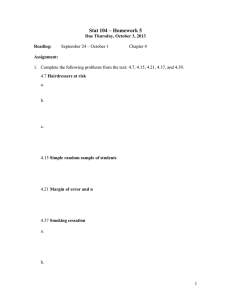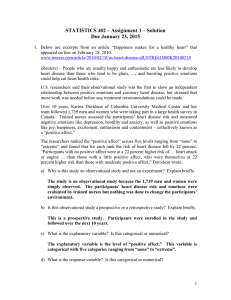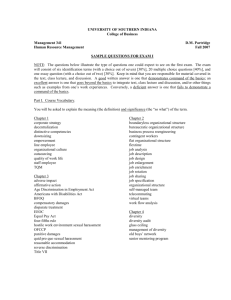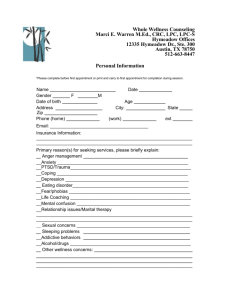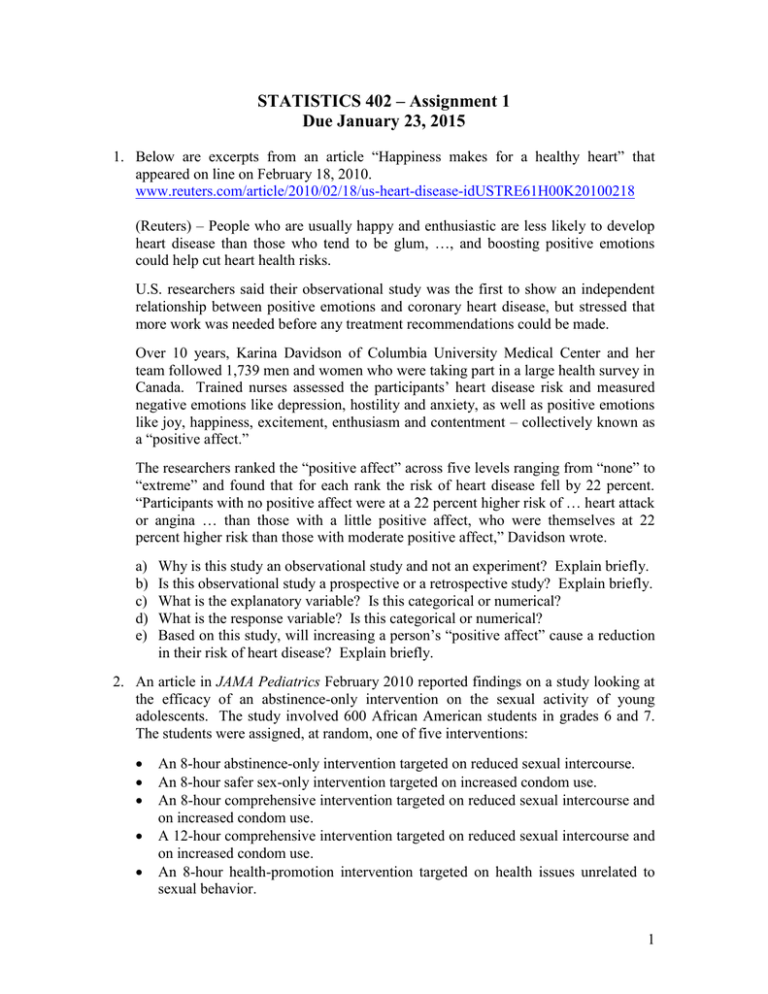
STATISTICS 402 – Assignment 1
Due January 23, 2015
1. Below are excerpts from an article “Happiness makes for a healthy heart” that
appeared on line on February 18, 2010.
www.reuters.com/article/2010/02/18/us-heart-disease-idUSTRE61H00K20100218
(Reuters) – People who are usually happy and enthusiastic are less likely to develop
heart disease than those who tend to be glum, …, and boosting positive emotions
could help cut heart health risks.
U.S. researchers said their observational study was the first to show an independent
relationship between positive emotions and coronary heart disease, but stressed that
more work was needed before any treatment recommendations could be made.
Over 10 years, Karina Davidson of Columbia University Medical Center and her
team followed 1,739 men and women who were taking part in a large health survey in
Canada. Trained nurses assessed the participants’ heart disease risk and measured
negative emotions like depression, hostility and anxiety, as well as positive emotions
like joy, happiness, excitement, enthusiasm and contentment – collectively known as
a “positive affect.”
The researchers ranked the “positive affect” across five levels ranging from “none” to
“extreme” and found that for each rank the risk of heart disease fell by 22 percent.
“Participants with no positive affect were at a 22 percent higher risk of … heart attack
or angina … than those with a little positive affect, who were themselves at 22
percent higher risk than those with moderate positive affect,” Davidson wrote.
a)
b)
c)
d)
e)
Why is this study an observational study and not an experiment? Explain briefly.
Is this observational study a prospective or a retrospective study? Explain briefly.
What is the explanatory variable? Is this categorical or numerical?
What is the response variable? Is this categorical or numerical?
Based on this study, will increasing a person’s “positive affect” cause a reduction
in their risk of heart disease? Explain briefly.
2. An article in JAMA Pediatrics February 2010 reported findings on a study looking at
the efficacy of an abstinence-only intervention on the sexual activity of young
adolescents. The study involved 600 African American students in grades 6 and 7.
The students were assigned, at random, one of five interventions:
An 8-hour abstinence-only intervention targeted on reduced sexual intercourse.
An 8-hour safer sex-only intervention targeted on increased condom use.
An 8-hour comprehensive intervention targeted on reduced sexual intercourse and
on increased condom use.
A 12-hour comprehensive intervention targeted on reduced sexual intercourse and
on increased condom use.
An 8-hour health-promotion intervention targeted on health issues unrelated to
sexual behavior.
1
Two years after getting the intervention, the students reported whether they had
sexual intercourse or not. The estimated probability of having sexual intercourse by
the 24-month follow-up was 33.5% in the abstinence-only intervention and 48.5% in
the group that received the health-promotion intervention.
a)
b)
c)
d)
e)
f)
Why is this study an experiment and not an observational study?
Describe the experimental units in the experiment?
What is the response variable? Is this variable categorical or numerical?
What are the treatments? Be specific.
Is there a control/comparison group in the experiment? Explain briefly.
Explain briefly how interventions can be randomly assigned to the students. Your
explanation should be complete enough so that a person not knowledgeable in
statistics could follow your explanation and actually assign the interventions to
the students.
3. A study is performed on the effect of temperature on the strength of plastic welds.
Currently a temperature of 170 C is used for welding plastic parts. There are seven
different temperatures (140, 150, 160, 170, 180, 190 and 200 C). At each temperature
five specimens of the plastic material are welded. The welds are then subjected to a
load until the weld breaks. The maximum load (in Newtons) before the weld breaks
is the strength of the weld. The thirty five welds (5 specimens at each of 7
temperatures) are run in a random order. All welds are made with the same
equipment by the same operator. All strengths are measured with the same
equipment by the same operator.
a)
b)
c)
d)
Why is this study an experiment and not an observational study?
What is the response variable? Is this variable categorical or numerical?
What are the treatments? Be specific.
Identify an outside variable that is controlled in the study and indicate how that
variable is controlled.
f) Is there a control/comparsion group in the study? Explain briefly.
g) How is replication within this study accomplished?
2

